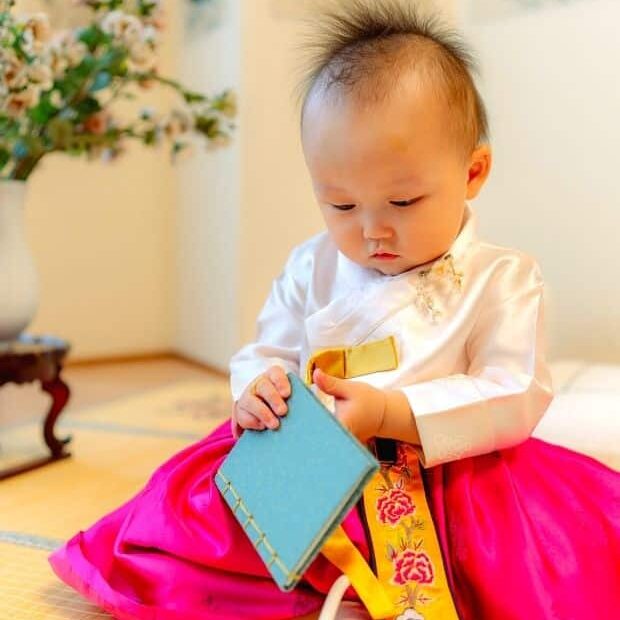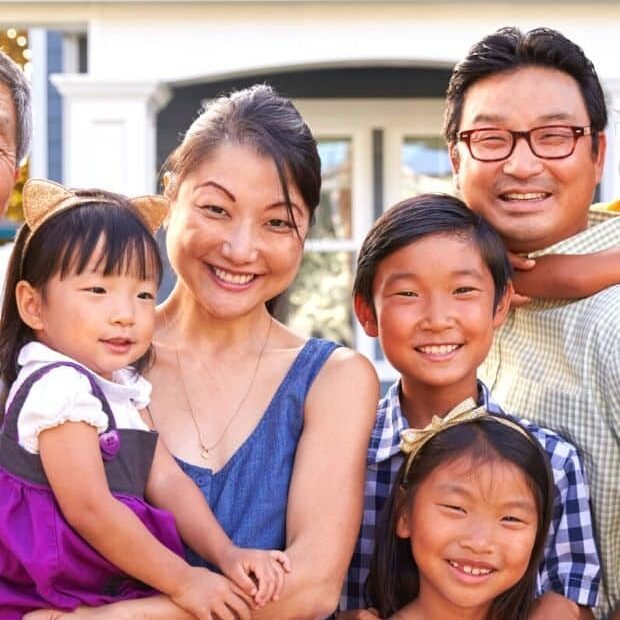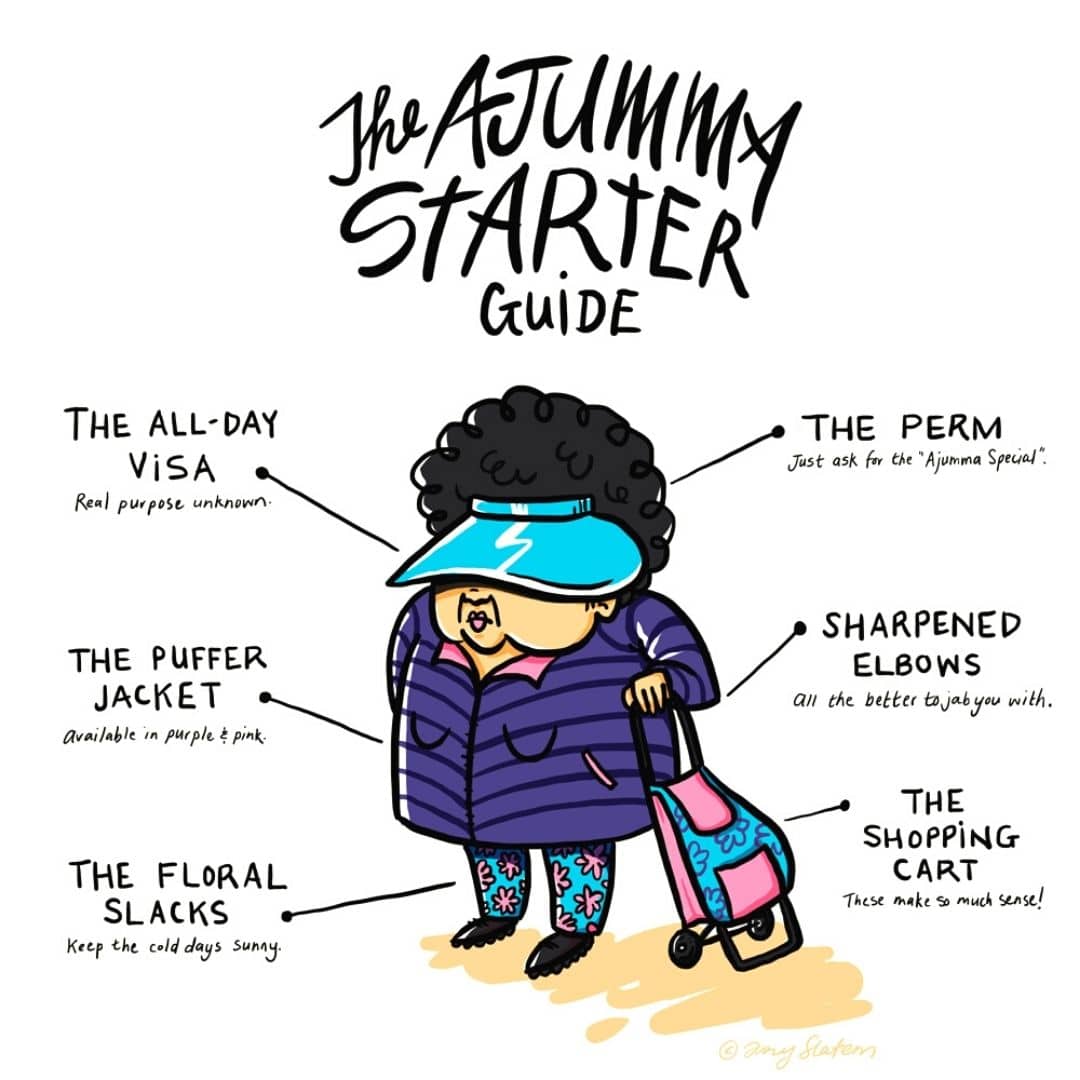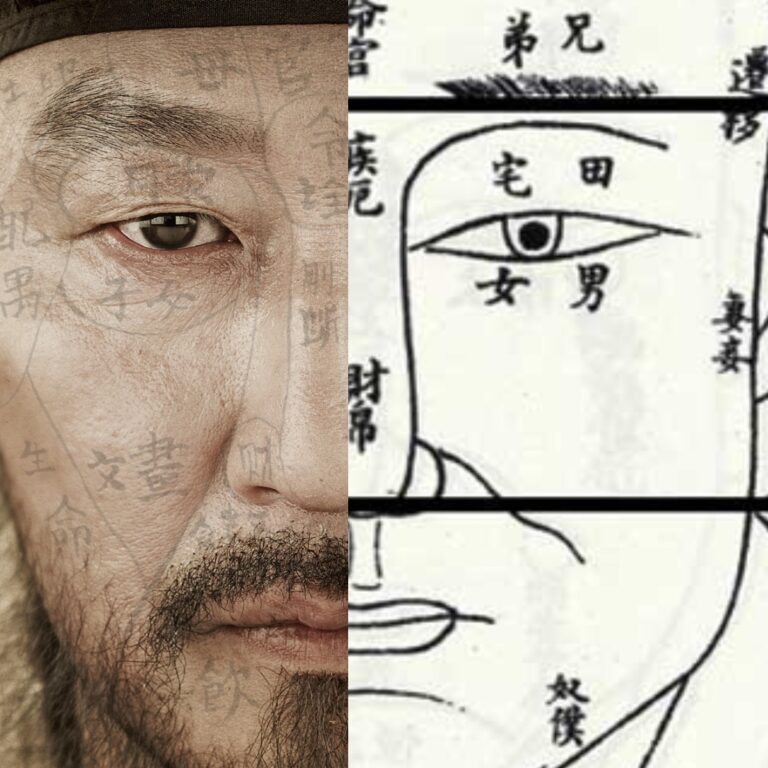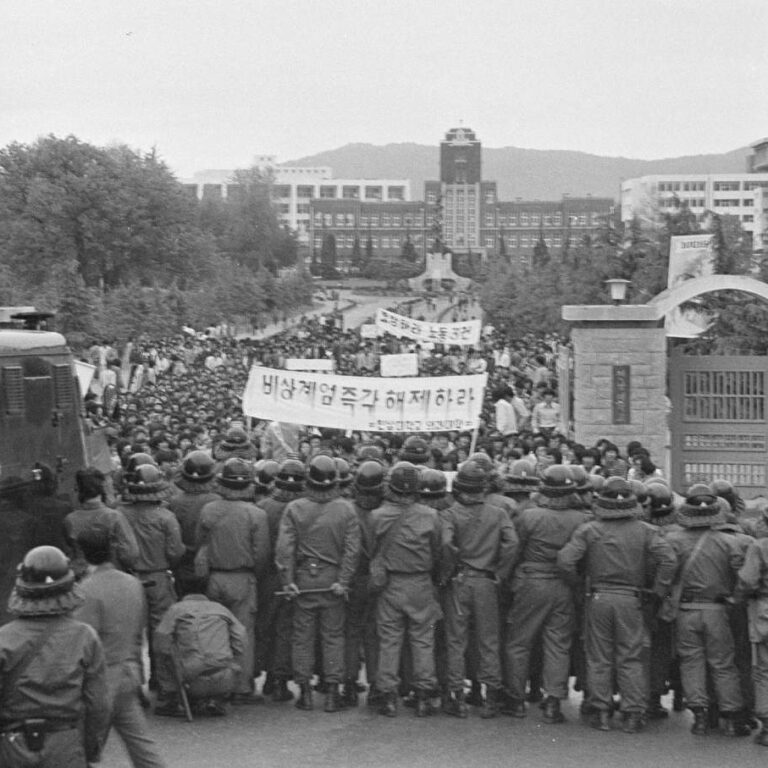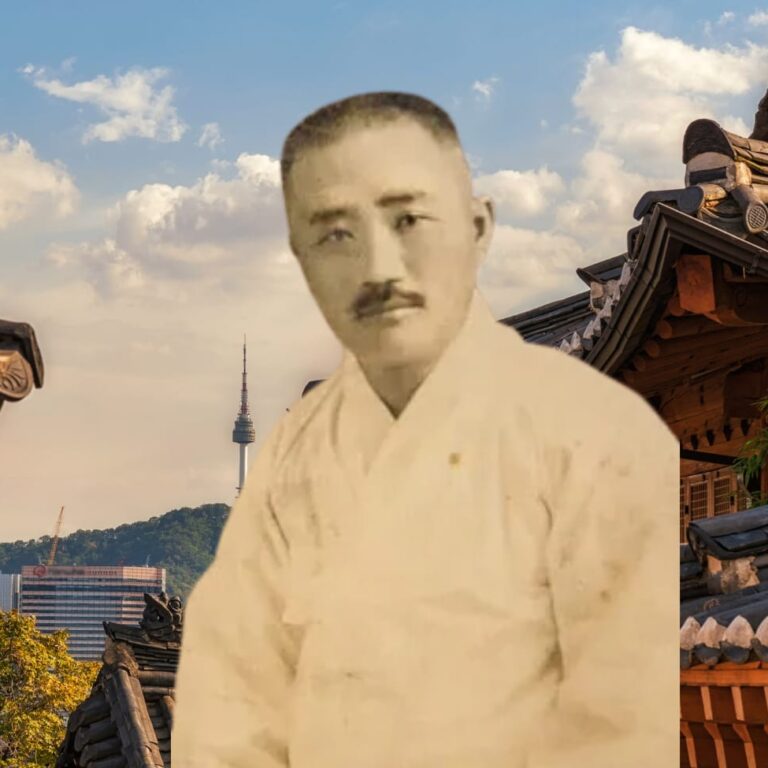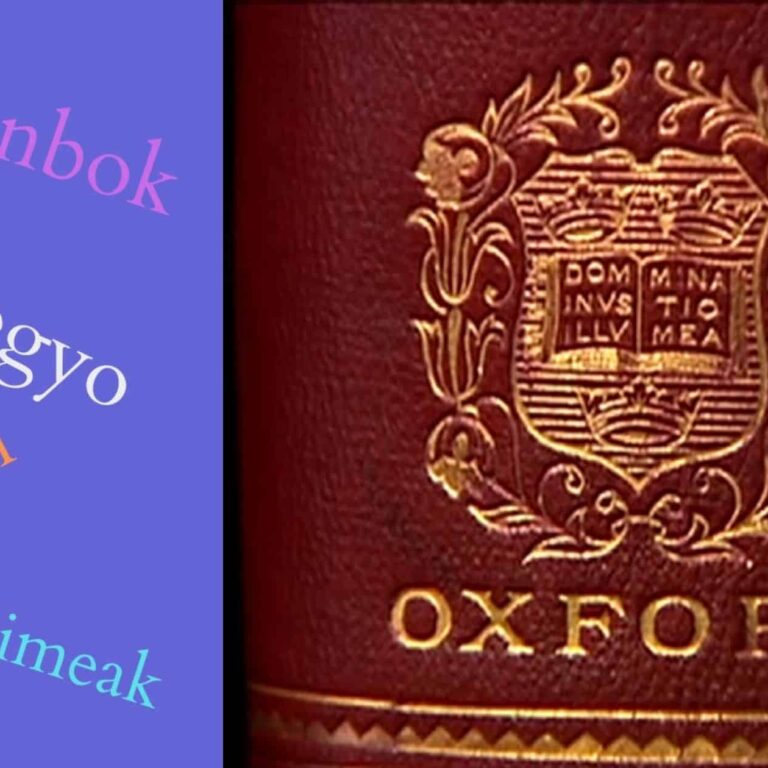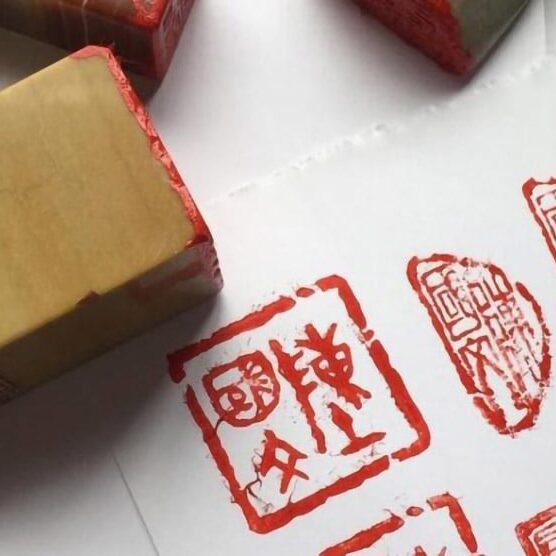Korea is a country rich in etiquette, culture, and customs that are sometimes oceans apart from what you’d find in the West. Part of this is due to the strong influence Confucian teachings have had on the development of Korean etiquette and culture over the last 1,500 years. In Korea, age and social status are closely tied together and are key to determining how to act, who does what, and even how to speak. If you want to understand why crossing your legs might cause offense, how to greet people properly, and why Koreans behave the way they do, then read on and discover all there is to learn about Korean etiquette and culture.

Meeting People In Korea
The first section of this guide to Korean etiquette is all about how to meet and greet people. There are some golden rules that you must avoid breaking, as well as some simple ways to make Koreans feel more at ease when you meet them. Follow these tips and you’ll be making friends in no time.
Whether you’re touching down at Incheon Airport for a journey through Korea, or hanging out with new Korean friends in your neighborhood, these Korean etiquette tips will help you make a good impression and avoid any uncomfortable situations.
First impressions are always very important and this is especially true in Korea, where formality is a crucial part of both the culture and language. Knowing the correct way to meet and greet people can help you make friends and show respect to Korean traditions and customs.
Here are three good ways you can meet and greet people in Korea.
- Bow to greet people: A slight bow is a common courtesy when meeting people in Korea. The deeper the bow, the more respect you show. However, you typically don’t need to bow too much unless you’re in a very formal situation.
- Bow to say goodbye: Bowing is also the normal way to say goodbye in Korea. When someone is departing, bow or nod to wish them well on their journey. If you’re leaving, bow when you leave the room or just before you enter a vehicle.
- Two-handed shake: A handshake is another typical form of greeting in Korea, especially for men. A two-handed handshake is preferred, with either both hands clasping the other person’s hands, or the spare hand on your wrist, elbow, or waist.
Now that you’ve introduced yourself to someone in Korea, make sure to avoid any Korean etiquette mistakes by keeping your hands to yourself. While gestures like a pat on the back, hug, or other close physical contact are ways to make friends in the USA, they can have a very different effect on Koreans.
Korea is a largely formal, conservative society where public image and behavior are key to maintaining harmony. Overactive body language can cause embarrassment for others and break that harmony. When in doubt, keep your hands to yourself.
Here are three ways to avoid offending Koreans when you meet them.
- Avoid hugging: Hugging and close physical contact is generally frowned upon in Korea unless people are close friends. Hugging a stranger could make them feel very uncomfortable and would be especially rude with older Koreans.
- Watch your body language: Besides close physical contact, there are some other ways you might offend Koreans with your body. Crossing your legs in front of someone is considered rude, as is waving your arms about near others.
- Don’t use first names: Try to avoid using first names in Korea unless you know that person already. For strangers, it is best to refer to them by their title (e.g. Mr. Kim) or professional titles. In Korea, the name order is reversed – surnames first, first names last.
While gift giving is a lovely practice, and one that’s welcomed in Korea, it can also be a minefield of etiquette errors waiting to explode. Use two hands to give and receive gifts from elders and in work settings. A small bow when gift giving or receiving a gift is a must.
Friends will often give each other small gifts, and there are a number of occasions when you might give or receive gifts from friends, coworkers, or partners. When buying a gift, don’t spend too much money, as this places a burden on the other person to reciprocate with an expensive gift.
Here are three important Korean etiquette rules to remember when giving and receiving gifts in Korea.
- Two-hand rule: When giving and receiving items (and handshakes), use two hands to show respect. This includes paying for items in a shop, receiving gifts, and pouring / receiving drinks from anyone. This rule isn’t so strict for younger Koreans or people familiar to you.
- Return the favor: If someone in Korea buys you a gift, it’s customary to reciprocate at an appropriate time with a gift of similar value. Western gifts are a good idea, as well as items such as chocolates, cakes, and flowers. Make sure to wrap the gifts or place them in a neat bag.
- Wait to open: If you receive a gift in Korea, make sure not to open it immediately. Look at the wrapping, say thanks, then put it to one side and open it later when you’re alone, unless they encourage you to open it immediately. Opening it instantly may cause embarrassment for the giver.
Here are a few tips to help you build good relationships with your new Korean friends, neighbors, or acquaintances. Navigating the murky waters of conversation can be difficult, with subtlety and harmony being key elements of polite conversation in Korea.
What this boils down is to being able to read the signals that Koreans might be uncomfortable or embarrassed, even when they don’t directly state a problem. This Korean etiquette guide will cover socializing in more detail in the next section, including Korean dining out and drinking etiquette tips.
Here are three Korean etiquette rules to keep and grow your connections in Korea.
- Just say yes: It’s poor Korean etiquette to say ‘no’ when given an offer or invitation. If you the person you’re asking is trying to avoid answering, take a hint and drop it. If you’re asked to do something, say yes, or find a way to let them down gently.
- Take a hint: Besides avoiding negative answers, Koreans may be indirect, giving hints instead of saying things out loud. Watch out for subtle comments about things that may be an issue. People may be too embarrassed to complain directly.
- Watch your hands: Try to avoid pointing at people with your index finger in Korea as it’s considered rude. Also, when you beckon people with your hand, make sure your palm is facing down towards the ground, not up to the sky.
Socializing Etiquette In Korea
In this section of the Korean etiquette guide, you’ll learn more about group harmony and hierarchy and how they can influence even the simplest interactions like eating out together, sitting at a table, and sharing drinks. If you want to make friends in Korea and show you appreciate Korean culture, these etiquette tips will help you make a great impression.
Dining out in Korea is one of the most enjoyable experiences you can have. It’s also one that has a lot of hidden rules just waiting to trip you up. If you’re visiting Korea for business purposes, you’ll want to pay extra attention to these dining etiquette rules to make a lasting positive impression and to avoid upsetting anyone accidentally.
Korean dining culture is very different from typical dining culture in the West, with a strong focus on a group experience that respects social hierarchy. Rather than everyone ordering separate meals, it’s more common to order a large meal for everyone to share, eating from a large selection of smaller dishes and a central main dish. Respect is also key, making sure the VIPs get the best seats and take the first bite.
Here are three essential Korean etiquette tips for dining out in Korea.
- Wait to be seated: When you arrive at a group meal, especially in a formal or work setting, don’t rush to grab the first chair or spot on the ground that you see. Seats are assigned based on social hierarchy, with the most senior or respected taking the central seats. Wait for the senior members to be seated, then sit down to eat.
- Follow your elders: Korean etiquette states that the oldest are served first at meals. All eyes look to the most senior person to take the first bite. At that point, everyone else can start eating. The more formal the setting, the stricter the adherence. The same generally applies for drinks and a toast will be made before people start drinking.
- Watch your chopsticks: Chopsticks are an essential part of every Korean meal and essential when traveling to Korea. Here are some key etiquette rules you should follow when using them. First, never point chopsticks at people, it’s considered rude. Second, don’t stand them up in rice, this is done at funerals and symbolises death.
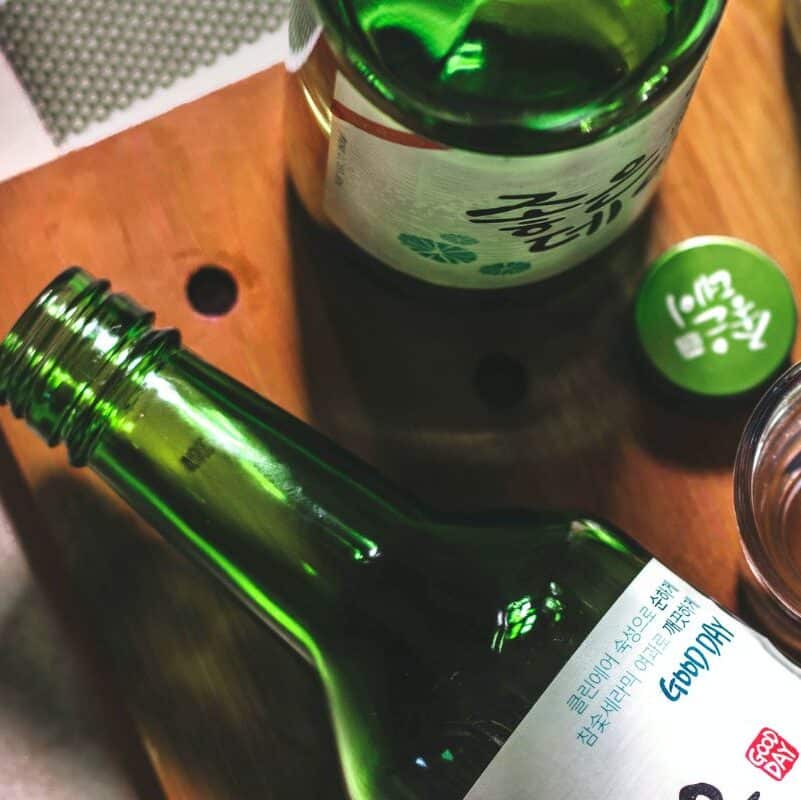
Drinks are served in small glasses (beer) or shot glasses (soju) and often drunk in one go (shouting ‘one-shot!’). Toasts are popular in Korea, and if you’re invited to a dinner or drinks party, you’re likely be asked to give a small speech or toast. After a shared meal, some Koreans like to go out for a ‘second round’, which involves going to a bar for more drinks, or a noraebang for singing.
Find out more about do’s and don’ts at a Korean dinner.
Here are three shots of Korean etiquette advice for when you’re out drinking with Korean people.
- The pouring hierarchy: The most senior person pours the first drink of the night for the younger person. After this, it’s the job of the younger person to refill the elders’ drinks for the remainder of the night. If there is no clear hierarchy, pour for others to be safe. Remember the two-hand rule when pouring drinks to show respect.
- Don’t pour for yourself: As well as pouring for your seniors, you should also pour for others when possible, and they will do the same for you. There is a Korean superstition about pouring drinks for yourself, which is why people avoid doing it. The old saying states that if you pour your own drink, you’ll never get married!
- Turn your head: Once you’ve poured drinks, turn your head away from the senior members of the group. It’s considered rude to face an older person straight-on when you drink alcohol. Instead, turn your head either to the right or left when you drink, and always put your hand over your mouth when upturning your cup.
It might seem rather ironic, that after a night out eating and drinking together, sharing together as a group, that the issue of who pays the bill isn’t handled in the same way in Korea. Rather than ‘going dutch’ (splitting the bill), it’s often one person who pays for the whole meal. This depends on the situation, with work or formal dinners being a bit more rigid than going out with friends.
For a work meal, it will usually be the boss (or most senior person) who pays. If someone invites you out, they’re likely to pay the bill before the end of the meal so the issue of splitting the bill doesn’t come up. When dining with friends, you might take it in turns to pay each time. Either way, it’s best not to argue about the bill to avoid embarrassing others.
Here are three useful Korean etiquette tips for settling the bill in Korea.
- Who pays the bill?: Being younger ‘pays’ when it comes to picking up the tab because the older and more senior person usually settles the bill. The older takes care of the younger and the younger honors the older in other ways, such as by pouring drinks and serving during the meal. With friends, one person might offer to pay the bill for everyone.
- Return the favor again: If a friend treats you to dinner or drinks, be sure to return the favor and treat them another time. If you openly offer to pay for the meal in advance, they might decline, feeling like they’re burdening you. Therefore, invite them out and when it comes time to settle the bill, rush to the counter before them and settle the bill.
- No tipping, please: This might be one of the hardest Korean etiquette rules for visitors from the US to get used to. Tipping is not a common practice in Korea and a service charge is very rarely added to the bill. There is a no-tipping culture in Korea and if you leave money behind as a tip, it’s likely to be returned to you.

Don’t pour your own drinks, eat with others, and be prepared to give a speech or two if drinking. Once your time is up, show your gratitude to the host and offer to host them if you can. The host might escort you out, which is also a sign of respect.
Here are three ways to be the perfect guest when visiting someone’s house in Korea.
- Bring a gift: If you’re invited to someone’s house, bring a small gift such as sweet foods or breads. Bakeries in Korea offer lots of options for gifts like this. Flowers are also a good option, but don’t be too fancy or else the host will feel obliged to return a similarly expensive gift. Gift wrapping is always welcome.
- Remove your shoes: When you accept an invitation to someone’s house and you’ve made an appropriately deep bow of greeting, remember to also remove your shoes. All Korean homes have a landing/foyer for removing shoes and changing into slippers. It’s considered unlucky to wear shoes inside, as well as simply being dirty.
- Slippers for the toilet: If you need to use the restroom when visiting a Korean house, or when eating in a traditional Korean restaurant, you’ll need to make one more footwear change. There are separate slippers for the bathroom that you should change into before entering. Just remember to take them off when you’re done!
How Korean Social Hierarchy Influences Etiquette
In order to understand why these Korean etiquette rules exist, this section will teach you all about Korean social order and hierarchy. From the ancient teachings of Confucius, to the bright puffer jackets of modern Korean ajummas, there’s a lot of interesting aspects of Korean culture that will help you understand why Koreans are the way they are.
Discover the five different relationships in Korean society, how they might lead you to ask for someone’s 이름 (i-reum) or 성함 (seong-ham), and how kibun and nunchi are essential parts of Korean culture. Before learning about all of those, however, here’s a quick overview of the most important influence on Korean social hierarchy – Confucius.
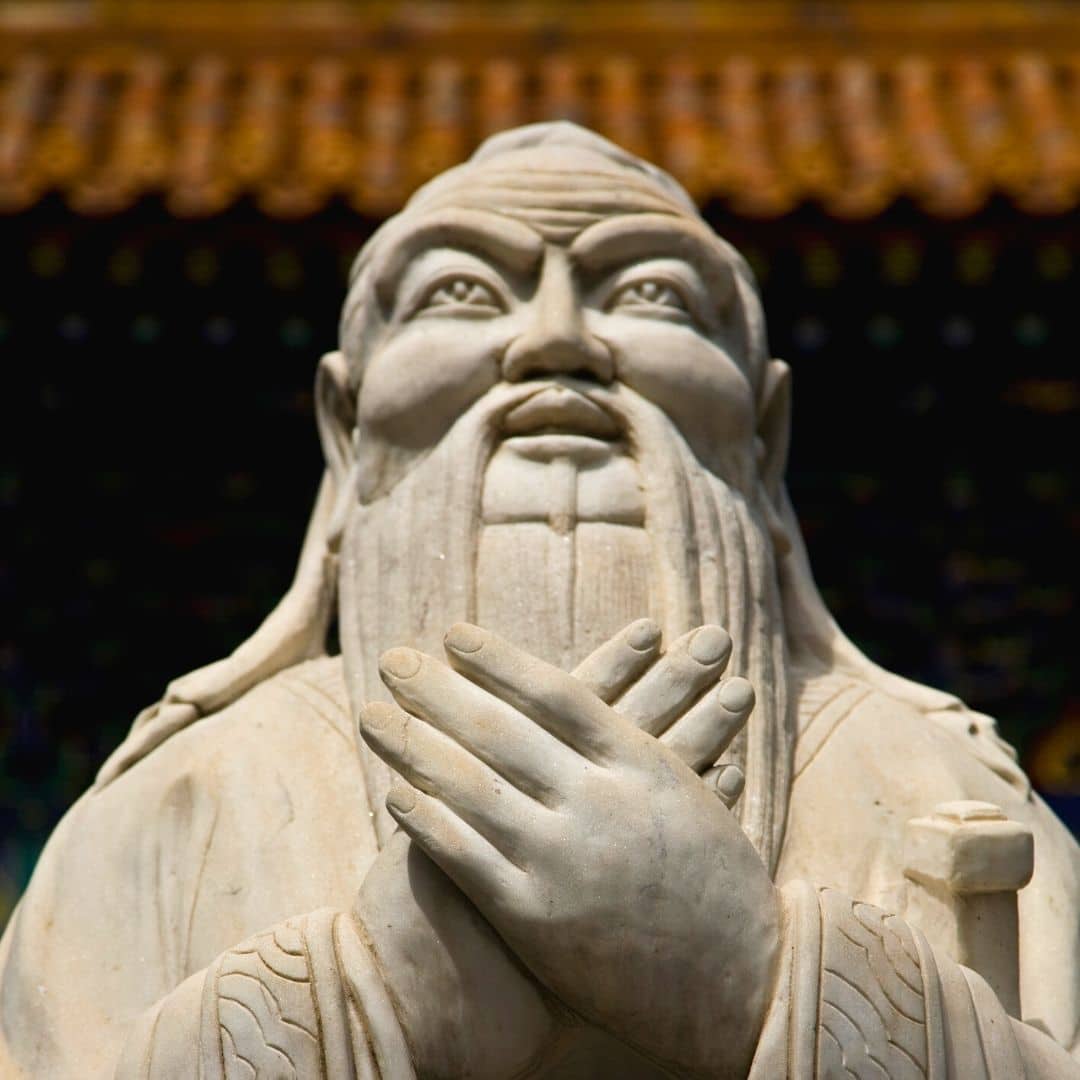
Morals, laws, and etiquette have all been shaped by these teachings and the result is a culture and society that is often confusing and misunderstood by Western visitors, but one that is welcoming and friendly. There are many positive elements of Korean culture and etiquette that have come from Confucian teachings, such as respect for elders, generosity to strangers, and the avoidance of conflict.
In modern Korea, you can see this in the friendly service at restaurants, cafes, and shops (as well as the lack of tipping). You will also see it when you travel on the subway and see reserved seats for the elderly or needy that are actually given to them. Strangers will help you out in need without any expectation of a reward and if you visit Korea alone, you might find some friendly locals looking to chat and learn more about you and your culture.
However, whilst there are many positive aspects of Confucianism, there are some things to watch out for. Disrupting group harmony with loud or offensive actions, even crossing your legs or hugging someone, can make your Korean friends or hosts uncomfortable. And they’re unlikely to mention it due to the desire to avoid conflict and embarrassment for you or them.
The clash between Western (individualistic) and Korean (collectivist) culture usually isn’t an issue for travelers visiting Korea, as tourists are treated as outsiders to Korean society. However, if you plan to live in Korea, it’s important to understand that 9 times out of 10, the group comes first. Speaking up and being ‘loud and proud’ are not valued qualities in Korea, where good people are considered to be humble and follow the rules. Understanding your position in Korean society, based on your age or social rank, is the key to knowing how to behave and what to do.
Although US travelers might feel like there’s an ocean between the two cultures, there are a lot of values and morals that both cultures share. Friendship, generosity, and respect are important for both Americans and Koreans. The main difference is the way these values are shown.
Find out more about how Confucianism has impacted Korean society.
Another aspect of Confucian teachings is a rigid social structure based on age and social standing. Someone’s social standing is based on their family, upbringing, wealth, education, and occupation, although these are less important nowadays than they were during the Korean Joseon-era.
There are 5 different hierarchical relationships in traditional Korean society: King to subject, husband to wife, father to son, elder to younger, and friend to friend.
Only the friend to friend relationship is considered equal, which is why a lot of Koreans keep friends their own age – you don’t need to worry about hierarchy rules.
Knowing someone’s age can help you determine their ‘place’ within the social hierarchy and therefore how you should behave with them.
It’s quite common for strangers to either directly ask, ‘How old are you?’, or try to find out your standing through indirect questions.
Some people might be shocked to be asked their age, but it’s a necessary part of social interaction and Korean people don’t feel embarrassed to ask.
If you’re not certain about someone’s position in the social hierarchy, it’s best to show respect and be polite, which is always good advice anyway.
One thing that a lot of visitors to Korea struggle with are the more subtle, hidden aspects of Korean etiquette and culture known as ‘kibun’ and ‘nunchi’. To navigate social events in Korea, you’re going to have to know how and why kibun and nunchi are so important.
What is kibun? There’s no direct translation in English, but it can be summed up as a person’s sense of face, pride, feelings, honor, or state of mind. Kibun is closely tied to one’s position in society and whether you are respected by others. If a manager criticizes an employee, the employee’s kibun is damaged. If the employee doesn’t show proper respect, the manager’s kibun is damaged.
When you damage someone’s kibun, you’re causing them to lose dignity (face) in front of others, which can hurt their pride. Maintaining kibun is essential for a harmonious environment at all times. Koreans will seek to avoid damaging kibun, even if it means telling ‘white lies’ or avoiding conflict.
What is nunchi and how is it related to kibun? Well, nunchi is the ability to determine another’s kibun, to be able to sense their feelings and knowing what is needed to maintain everyone’s kibun in a harmonious way. Nunchi can be achieved by observing other people’s body language, and by listening to the tone of their voice and what they say.
Feeling confused about how this all works? It’s understandable. Kibun and nunchi are very nuanced and something that happens in the back of most people’s mind. Just be aware that confrontations will be avoided at almost any cost, even when it might not be the best or most practical option.
Confucian values and social hierarchy are present in all parts of Korea, including the language. If you want to learn to speak Korean, you should be aware of how social values are reflected in the Korean language, including special forms of speech for certain people.
The first thing to be aware of is that Korean has several different forms of speech, typically referred to as informal, formal, and respectful. The latter is a form reserved for your elders or superiors. It’s also used by shops and restaurants to show respect to customers.
Formal and respectful Korean is known as 존댓말 (jon-daet-mal) while informal Korean is known as 반말 (ban-mal). While formal and informal Korean are mostly the same, respectful Korean has a different vocabulary for certain words. For example, the word ‘name’ in informal or formal is 이름 (i-reum), but in respectful Korean it’s 성함 (seong-ham). Thankfully, there are only a certain number of words that are different and they mostly relate to personal topics like family and home life.
When you want to address someone, you can show deference by referring to someone by their job title or a relation. For example, you might call someone ‘boss’ or ‘aunty’, rather than use their actual names. If you’re not sure what their name is, you can call them 선생님 (seon-saeng-nim), which means ‘teacher’, a respected position in Korean society. If the person is your peer, saying the person’s name is acceptable, but be sure to add the honorific 님 (nim) or 씨 (sshi).
Find out more about Korean honorifics.
The family is the core of Korean society, just as it is other countries around the world. Unlike many Western countries, however, the strict adherence to Confucian ideals has led to stronger family ties, traditions, and hierarchy rules. It’s worth noting that the following is based around traditional Korean ideals, some of which may be changing as Korea becomes more intertwined with the global society.
One key concept of Korean family life is filial piety – respecting one’s parents and elders. So much of Korean etiquette is rooted in filial piety, from the language used to speak to your elders, the terms used to address family members, and ceremonies honoring relatives that have moved on.
Parents will care for their children and do their best to give them as much of an advantage in life as possible. This can be seen through the large amounts of money spent on private tuition for children and generous support to help them buy their first home. Children are expected to respect their parents and be obedient in return, as well as look after their parents when they retire.
Americans may be shocked to hear that arranged marriages are still common in Korea, as is matchmaking by parents and friends to help people find their true love. Divorce rates are typically very low, with the idea of getting divorced considered unthinkable until recently.
Korean family names don’t work in the same way as they do in the US. Children typically take the surname of the father. Married women also keep their own surname instead of changing it. The eldest son is meant to be responsible for the family and care for his parents when they retire.
No guide to Korean social hierarchy would be complete without mentioning the queens of Korean society – the ajumma (아줌마). ‘Ajumma’ is a term used to describe a married, middle-aged woman and is loosely translated as ‘aunty’.
Whether you’re in Koreatown, downtown Seoul, or hiking in a Korean national park, you won’t be able to avoid the ever-busy ajumma as they go about their day haggling for discounts, chatting, and commenting on the world and its problems.
These ladies seem to revel in breaking the rules of Korean social order by pushing their way onto subways and buses, talking loudly in public, and wearing bright, colorful clothes that cause them to stand out. Confucius would be spinning in his grave!
If you’ve seen Kim’s Convenience, Jean Yoon’s character, Umma, was the perfect example of a Korean ajumma, although she wasn’t sporting a big enough perm.

Korean Etiquette Taboos: What You Shouldn’t Do
Korea is a tolerant society with friendly, welcoming people who will usually not point out cultural faux pas or embarrassing mistakes made by foreigners. However, this doesn’t mean that you would want to commit such atrocities and upset your Korean friends or hosts.
While there are seemingly never-ending ways you might offend someone in Korea, there are some easy to remember etiquette taboos that you can do easily and save yourself from a lot of trouble and awkward situations.
A lot of them are to do with eating, such as not pointing with chopsticks, not wearing shoes inside a restaurant, and using wet wipes instead of licking your fingers. Others are about personal space and not getting too close to other people, even those you’re madly in love with (including K-Idols!).
Here are six simple etiquette taboos to avoid to save your bacon.

Those unfamiliar with Korean and East Asian cultures may be shocked by the many ways you might accidentally wish someone was dead or bestow bad luck on others. Did you know red ink, chopsticks, and the number 4 are all tied to death and funerals?
On the subject of death, another unusual Korean superstition is that electric fans can kill you if left on at night. Ever since the 1920s, Koreans have been wary of the whirling blades of death that are trying to keep people cool at night. Find out more about the Korean fan death myth.
Here are three spooky superstitions to watch out for in Korea.

Exploring Korea’s Religious Beliefs & Customs
Korea is a country with a complex religious makeup, but also one where the majority of people don’t associate themselves with a religion (57% of Koreans). It’s also a country where people will go to a fortune teller before they get married to check if their future spouse is right for them, pay their respects at Buddhist temples, and hold ceremonies throughout the year to honor their dead ancestors.
The two major religions, Buddhism and Christianity, are a world apart, both spiritually and physically. Christianity, which entered Korea through Chinese Confucian scholars, has had a turbulent history in Korea, including the Catholic Persecution of 1866 where 8,000 Christian priests were executed.
Buddhism has been around far longer than Christianity, with some of the first Buddhist temples erected more than 1,700 years ago. Both Buddhism and Christianity are outdated by a long way when compared to Korea’s prehistoric animistic shamanistic traditions.
If you want to experience the vast network of Korea’s temples, shrines, and churches, remember to do so with respect. These places are welcoming to tourists and those eager to learn, but there are also etiquette rules to follow in these holy places. Shoes are forbidden inside temples, and most places will ask you not to eat or drink inside. Try to avoid disturbing monks and priests, especially when they’re in the middle of worship or a ceremony. Basically, act as you would do when you’re a guest.

When you explore Korea, you’ll certainly notice a lot of bright red crosses lighting up the night sky, with churches scattered far and wide between housing complexes and shopping centres. While Christianity has taken hold in the urban areas, you’ll discover Buddhist temples more frequently in the countryside, especially in Korea’s national parks. This is due to the spiritual connection between nature, the mountains, and Buddhist beliefs.
If you are interested in learning about Korean Buddhism, then a Korean temple stay is a fantastic opportunity to see the inner workings of a Buddhist temple, talk with Buddhist monks, and sleep overnight in a traditional temple
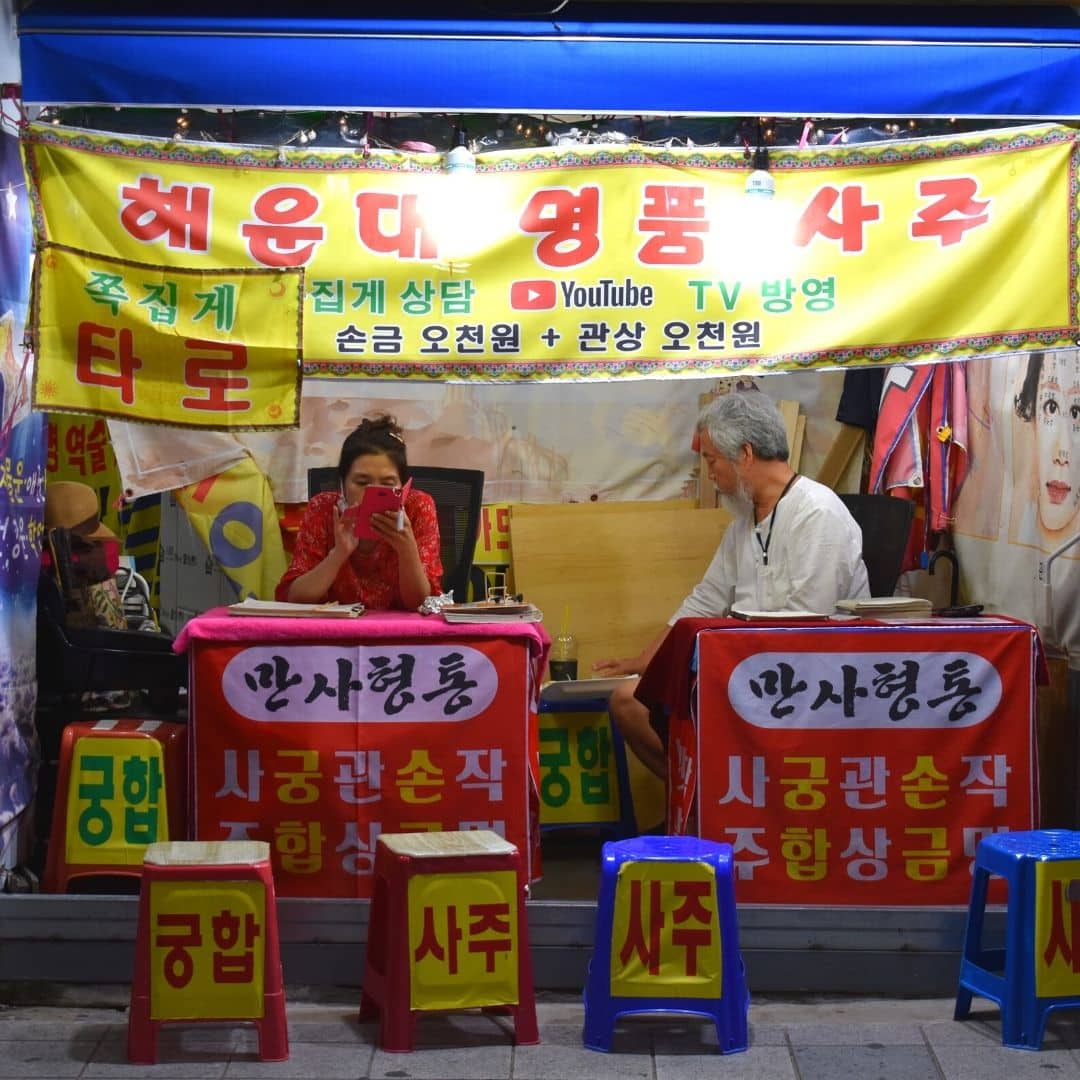
Korean shamanism involves the worship of gods, nature spirits, and one’s ancestors. Korea’s latest President is one of the most prominent believers in Korean shamanism. Korean shamans, all 150,000 of them, act as a go between for the spiritual world and the material world, helping to solve daily problems through gut rituals – songs, dances, and prayers for the gods and ancestors.
Fortune telling and tarot is also very popular in Korea, with more than 300,000 claiming to converse with the spirits of the dead (for a small fee). You can find fortune tellers across Korea, usually with small stands shown in the picture. Koreans typically visit fortune tellers before getting married, before exams, or at the end of the year to find out their fortune for the year ahead.

Korean Work Etiquette & Culture
Business travelers should be especially careful with these Korean etiquette rules. Building lasting business relationships and trust in Korea will be a lot easier if you understand how Confucian principles and social hierarchy dominates the business world.
If you want to get ahead doing business in Korea, remember that Koreans want you to be friendly, trustworthy, honorable, and to show respect at both work and when out socializing. The deepest connections can be created not in the office, but at the bottom of a glass of soju.
Compared to socializing and family life, the pressures to follow etiquette and cultural norms are far greater in a Korean company. There is a stronger focus on kibun and nunchi than other visitors to Korea will experience. Remember, avoid conflict wherever possible and don’t make anyone else lose face through your actions. Accept and give items with two hands to show the greatest amount of respect, bow when greeting and leaving someone, and try to speak a bit of Korean to create a good impression.
The work ethic in Korea might seem very different from the US. Koreans, especially public workers and those in large corporations like Samsung, will work long hours and stay in the office until late at night, leaving as late as midnight in some cases. Working over the weekend might also be expected, but isn’t that common. Koreans can feel uncomfortable saying no to requests, which can leave some working extra hours when asked to.
Families dominate the Korean business world and some of Korea’s largest conglomerates are run by families, including Samsung. Family members obtain management positions throughout the organisation, meaning there are lots of close connections between different business units. For outsiders trying to work out the various allegiances, family connections, and internal politics of a company, this can be very confusing.

The Korean workplace is perhaps the best example of a Confucian organisation you’ll find, with strict levels of hierarchy that are typically one-directional. Bosses tell the workers what to do and expect them to follow orders. Questioning those orders is seen as rude and can cause loss of face for the manager.
Korean companies devote a considerable amount of time and resources to building up team morale. This is done through a practice known as ‘membership training’, which is a form of team bonding.
This can involve day trips out together, work meals, even vacations away in other parts of Korea for a few days during the working week. Companies have special budgets to cover these expenses and see it as an investment in group harmony. However, this aspect of Korean culture is slowly eroding, especially among younger generations and those who want to spend time with their families.
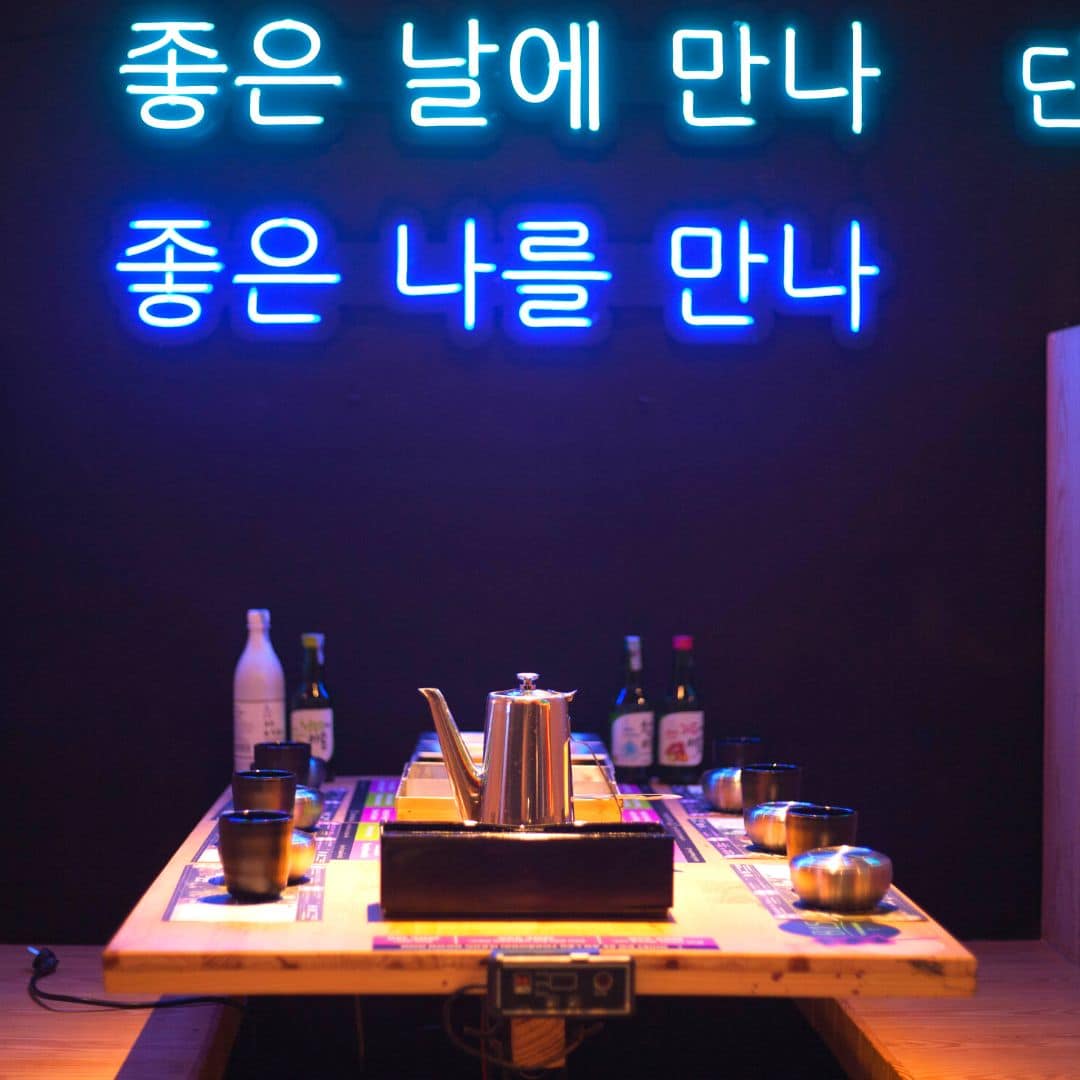
These social events are a great way to build connections with your Korean partners, and a bottle of soju or two helps everyone relax and get chatting. The aforementioned Korean etiquette rules for socializing will definitely help you out if you need to attend a work dinner. Remember to pour drinks for your seniors, wait for them to eat first, and don’t pour drinks for yourself.
Be careful when drinking soju, it goes down easy and you might not notice how drunk you are. Of course, you don’t have to drink to do business in Korea, but for many companies, it’s still a central part of socializing. If you’re not comfortable drinking a lot, drink the first toast then leave the glass full for the rest of the night. If your glass is empty, someone will fill it up for you.
Hungry for more Korean etiquette and culture insights? Here are some more Best of Korea articles to whet your cultural appetite. Read up about Traditional Korean Funerals and what happens when someone dies in Korea – it’s a very different situation than you’ll find in the USA. Korean Weddings are similarly unique, just like Korean Valentine’s Day traditions.
Actually, dating is very confusing in Korea because there’s not just 1 romantic day on February 14th, there are actually 12 Korean Romantic Dates throughout the year!Learn how people in Korea use Blood Types to determine someone’s personality and how you might not be able to find your perfect partner if the juice in your veins isn’t quite right!
To learn more about Korean culture, read on. Want to visit some cultural sights? Check out these Seoul K-Drama Filming Locations. Finally, here’s a guide to 15 Delightful Korean Children’s Books with more insights into Korean culture.
If you’re ready to travel to Korea, head over to our South Korea Travel Guide to start planning your trip right now.
This guide has only just brushed the surface of Korean etiquette and culture. There’s so much more to learn about Korea’s rich and unique culture, traditions, customs, and beliefs. Be sure to keep checking back with the Best of Korea for more insights and interesting articles.
Meeting People In Korea
The first section of this guide to Korean etiquette is all about how to meet and greet people. There are some golden rules that you must avoid breaking, as well as some simple ways to make Koreans feel more at ease when you meet them. Follow these tips and you’ll be making friends in no time.
Whether you’re touching down at Incheon Airport for a journey through Korea, or hanging out with new Korean friends in your neighborhood, these Korean etiquette tips will help you make a good impression and avoid any uncomfortable situations.
First impressions are always very important and this is especially true in Korea, where formality is a crucial part of both the culture and language. Knowing the correct way to meet and greet people can help you make friends and show respect to Korean traditions and customs.
Here are three good ways you can meet and greet people in Korea.
- Bow to greet people: A slight bow is a common courtesy when meeting people in Korea. The deeper the bow, the more respect you show. However, you typically don’t need to bow too much unless you’re in a very formal situation.
- Bow to say goodbye: Bowing is also the normal way to say goodbye in Korea. When someone is departing, bow or nod to wish them well on their journey. If you’re leaving, bow when you leave the room or just before you enter a vehicle.
- Two-handed shake: A handshake is another typical form of greeting in Korea, especially for men. A two-handed handshake is preferred, with either both hands clasping the other person’s hands, or the spare hand on your wrist, elbow, or waist.
Now that you’ve introduced yourself to someone in Korea, make sure to avoid any Korean etiquette mistakes by keeping your hands to yourself. While gestures like a pat on the back, hug, or other close physical contact are ways to make friends in the USA, they can have a very different effect on Koreans.
Korea is a largely formal, conservative society where public image and behavior are key to maintaining harmony. Overactive body language can cause embarrassment for others and break that harmony. When in doubt, keep your hands to yourself.
Here are three ways to avoid offending Koreans when you meet them.
- Avoid hugging: Hugging and close physical contact is generally frowned upon in Korea unless people are close friends. Hugging a stranger could make them feel very uncomfortable and would be especially rude with older Koreans.
- Watch your body language: Besides close physical contact, there are some other ways you might offend Koreans with your body. Crossing your legs in front of someone is considered rude, as is waving your arms about near others.
- Don’t use first names: Try to avoid using first names in Korea unless you know that person already. For strangers, it is best to refer to them by their title (e.g. Mr. Kim) or professional titles. In Korea, the name order is reversed – surnames first, first names last.
While gift giving is a lovely practice, and one that’s welcomed in Korea, it can also be a minefield of etiquette errors waiting to explode. Use two hands to give and receive gifts from elders and in work settings. A small bow when gift giving or receiving a gift is a must.
Friends will often give each other small gifts, and there are a number of occasions when you might give or receive gifts from friends, coworkers, or partners. When buying a gift, don’t spend too much money, as this places a burden on the other person to reciprocate with an expensive gift.
Here are three important Korean etiquette rules to remember when giving and receiving gifts in Korea.
- Two-hand rule: When giving and receiving items (and handshakes), use two hands to show respect. This includes paying for items in a shop, receiving gifts, and pouring / receiving drinks from anyone. This rule isn’t so strict for younger Koreans or people familiar to you.
- Return the favor: If someone in Korea buys you a gift, it’s customary to reciprocate at an appropriate time with a gift of similar value. Western gifts are a good idea, as well as items such as chocolates, cakes, and flowers. Make sure to wrap the gifts or place them in a neat bag.
- Wait to open: If you receive a gift in Korea, make sure not to open it immediately. Look at the wrapping, say thanks, then put it to one side and open it later when you’re alone, unless they encourage you to open it immediately. Opening it instantly may cause embarrassment for the giver.
Here are a few tips to help you build good relationships with your new Korean friends, neighbors, or acquaintances. Navigating the murky waters of conversation can be difficult, with subtlety and harmony being key elements of polite conversation in Korea.
What this boils down is to being able to read the signals that Koreans might be uncomfortable or embarrassed, even when they don’t directly state a problem. This Korean etiquette guide will cover socializing in more detail in the next section, including Korean dining out and drinking etiquette tips.
Here are three Korean etiquette rules to keep and grow your connections in Korea.
- Just say yes: It’s poor Korean etiquette to say ‘no’ when given an offer or invitation. If you the person you’re asking is trying to avoid answering, take a hint and drop it. If you’re asked to do something, say yes, or find a way to let them down gently.
- Take a hint: Besides avoiding negative answers, Koreans may be indirect, giving hints instead of saying things out loud. Watch out for subtle comments about things that may be an issue. People may be too embarrassed to complain directly.
- Watch your hands: Try to avoid pointing at people with your index finger in Korea as it’s considered rude. Also, when you beckon people with your hand, make sure your palm is facing down towards the ground, not up to the sky.
Socializing Etiquette In Korea
In this section of the Korean etiquette guide, you’ll learn more about group harmony and hierarchy and how they can influence even the simplest interactions like eating out together, sitting at a table, and sharing drinks. If you want to make friends in Korea and show you appreciate Korean culture, these etiquette tips will help you make a great impression.
Dining out in Korea is one of the most enjoyable experiences you can have. It’s also one that has a lot of hidden rules just waiting to trip you up. If you’re visiting Korea for business purposes, you’ll want to pay extra attention to these dining etiquette rules to make a lasting positive impression and to avoid upsetting anyone accidentally.
Korean dining culture is very different from typical dining culture in the West, with a strong focus on a group experience that respects social hierarchy. Rather than everyone ordering separate meals, it’s more common to order a large meal for everyone to share, eating from a large selection of smaller dishes and a central main dish. Respect is also key, making sure the VIPs get the best seats and take the first bite.
Here are three essential Korean etiquette tips for dining out in Korea.
- Wait to be seated: When you arrive at a group meal, especially in a formal or work setting, don’t rush to grab the first chair or spot on the ground that you see. Seats are assigned based on social hierarchy, with the most senior or respected taking the central seats. Wait for the senior members to be seated, then sit down to eat.
- Follow your elders: Korean etiquette states that the oldest are served first at meals. All eyes look to the most senior person to take the first bite. At that point, everyone else can start eating. The more formal the setting, the stricter the adherence. The same generally applies for drinks and a toast will be made before people start drinking.
- Watch your chopsticks: Chopsticks are an essential part of every Korean meal and essential when traveling to Korea. Here are some key etiquette rules you should follow when using them. First, never point chopsticks at people, it’s considered rude. Second, don’t stand them up in rice, this is done at funerals and symbolises death.
Alcohol is the fuel that powers many social events and is an integral part of helping everyone relax and have a good time together. It also gives people courage to belt out their favorite tunes at the after dinner noreabang (karaoke) party. Korean beer and soju are commonly served with a meal and are very cheap ($4 for a large bottle of beer or bottle of soju), which encourages people to order a lot.
Drinks are served in small glasses (beer) or shot glasses (soju) and often drunk in one go (shouting ‘one-shot!’). Toasts are popular in Korea, and if you’re invited to a dinner or drinks party, you’re likely be asked to give a small speech or toast. After a shared meal, some Koreans like to go out for a ‘second round’, which involves going to a bar for more drinks, or a noraebang for singing.
Find out more about do’s and don’ts at a Korean dinner.
Here are three shots of Korean etiquette advice for when you’re out drinking with Korean people.
- The pouring hierarchy: The most senior person pours the first drink of the night for the younger person. After this, it’s the job of the younger person to refill the elders’ drinks for the remainder of the night. If there is no clear hierarchy, pour for others to be safe. Remember the two-hand rule when pouring drinks to show respect.
- Don’t pour for yourself: As well as pouring for your seniors, you should also pour for others when possible, and they will do the same for you. There is a Korean superstition about pouring drinks for yourself, which is why people avoid doing it. The old saying states that if you pour your own drink, you’ll never get married!
- Turn your head: Once you’ve poured drinks, turn your head away from the senior members of the group. It’s considered rude to face an older person straight-on when you drink alcohol. Instead, turn your head either to the right or left when you drink, and always put your hand over your mouth when upturning your cup.
It might seem rather ironic, that after a night out eating and drinking together, sharing together as a group, that the issue of who pays the bill isn’t handled in the same way in Korea. Rather than ‘going dutch’ (splitting the bill), it’s often one person who pays for the whole meal. This depends on the situation, with work or formal dinners being a bit more rigid than going out with friends.
For a work meal, it will usually be the boss (or most senior person) who pays. If someone invites you out, they’re likely to pay the bill before the end of the meal so the issue of splitting the bill doesn’t come up. When dining with friends, you might take it in turns to pay each time. Either way, it’s best not to argue about the bill to avoid embarrassing others.
Here are three useful Korean etiquette tips for settling the bill in Korea.
- Who pays the bill?: Being younger ‘pays’ when it comes to picking up the tab because the older and more senior person usually settles the bill. The older takes care of the younger and the younger honors the older in other ways, such as by pouring drinks and serving during the meal. With friends, one person might offer to pay the bill for everyone.
- Return the favor again: If a friend treats you to dinner or drinks, be sure to return the favor and treat them another time. If you openly offer to pay for the meal in advance, they might decline, feeling like they’re burdening you. Therefore, invite them out and when it comes time to settle the bill, rush to the counter before them and settle the bill.
- No tipping, please: This might be one of the hardest Korean etiquette rules for visitors from the US to get used to. Tipping is not a common practice in Korea and a service charge is very rarely added to the bill. There is a no-tipping culture in Korea and if you leave money behind as a tip, it’s likely to be returned to you.
The chance to visit someone’s house in Korea is a great honor, especially given that this is usually a private place, reserved for family and select guests. In order to show your respect, there a few simple etiquette rules you can follow, such as removing your shoes when you enter and bringing a gift. Some of the aforementioned eating and drinking etiquette tips apply when you’re a guest, too.
Don’t pour your own drinks, eat with others, and be prepared to give a speech or two if drinking. Once your time is up, show your gratitude to the host and offer to host them if you can. The host might escort you out, which is also a sign of respect.
Here are three ways to be the perfect guest when visiting someone’s house in Korea.
- Bring a gift: If you’re invited to someone’s house, bring a small gift such as sweet foods or breads. Bakeries in Korea offer lots of options for gifts like this. Flowers are also a good option, but don’t be too fancy or else the host will feel obliged to return a similarly expensive gift. Gift wrapping is always welcome.
- Remove your shoes: When you accept an invitation to someone’s house and you’ve made an appropriately deep bow of greeting, remember to also remove your shoes. All Korean homes have a landing/foyer for removing shoes and changing into slippers. It’s considered unlucky to wear shoes inside, as well as simply being dirty.
- Slippers for the toilet: If you need to use the restroom when visiting a Korean house, or when eating in a traditional Korean restaurant, you’ll need to make one more footwear change. There are separate slippers for the bathroom that you should change into before entering. Just remember to take them off when you’re done!
How Korean Social Hierarchy Influences Etiquette
In order to understand why these Korean etiquette rules exist, this section will teach you all about Korean social order and hierarchy. From the ancient teachings of Confucius, to the bright puffer jackets of modern Korean ajummas, there’s a lot of interesting aspects of Korean culture that will help you understand why Koreans are the way they are.
Discover the five different relationships in Korean society, how they might lead you to ask for someone’s 이름 (i-reum) or 성함 (seong-ham), and how kibun and nunchi are essential parts of Korean culture. Before learning about all of those, however, here’s a quick overview of the most important influence on Korean social hierarchy – Confucius.
The ancient Chinese philosopher Confucius died over 2,500 years ago, yet still has a strikingly strong impact on Korean society. So much so that Korea is known as the most strictly Confucian society in the world. Confucius promoted societal harmony, compassion and empathy for others, and the need to put the group’s needs above individual needs. This has lead to Korea becoming a collectivist society.
Morals, laws, and etiquette have all been shaped by these teachings and the result is a culture and society that is often confusing and misunderstood by Western visitors, but one that is welcoming and friendly. There are many positive elements of Korean culture and etiquette that have come from Confucian teachings, such as respect for elders, generosity to strangers, and the avoidance of conflict.
In modern Korea, you can see this in the friendly service at restaurants, cafes, and shops (as well as the lack of tipping). You will also see it when you travel on the subway and see reserved seats for the elderly or needy that are actually given to them. Strangers will help you out in need without any expectation of a reward and if you visit Korea alone, you might find some friendly locals looking to chat and learn more about you and your culture.
However, whilst there are many positive aspects of Confucianism, there are some things to watch out for. Disrupting group harmony with loud or offensive actions, even crossing your legs or hugging someone, can make your Korean friends or hosts uncomfortable. And they’re unlikely to mention it due to the desire to avoid conflict and embarrassment for you or them.
The clash between Western (individualistic) and Korean (collectivist) culture usually isn’t an issue for travelers visiting Korea, as tourists are treated as outsiders to Korean society. However, if you plan to live in Korea, it’s important to understand that 9 times out of 10, the group comes first. Speaking up and being ‘loud and proud’ are not valued qualities in Korea, where good people are considered to be humble and follow the rules. Understanding your position in Korean society, based on your age or social rank, is the key to knowing how to behave and what to do.
Although US travelers might feel like there’s an ocean between the two cultures, there are a lot of values and morals that both cultures share. Friendship, generosity, and respect are important for both Americans and Koreans. The main difference is the way these values are shown.
Find out more about how Confucianism has impacted Korean society.
Another aspect of Confucian teachings is a rigid social structure based on age and social standing. Someone’s social standing is based on their family, upbringing, wealth, education, and occupation, although these are less important nowadays than they were during the Korean Joseon-era.
There are 5 different hierarchical relationships in traditional Korean society: King to subject, husband to wife, father to son, elder to younger, and friend to friend.
Only the friend to friend relationship is considered equal, which is why a lot of Koreans keep friends their own age – you don’t need to worry about hierarchy rules.
Knowing someone’s age can help you determine their ‘place’ within the social hierarchy and therefore how you should behave with them.
It’s quite common for strangers to either directly ask, ‘How old are you?’, or try to find out your standing through indirect questions.
Some people might be shocked to be asked their age, but it’s a necessary part of social interaction and Korean people don’t feel embarrassed to ask.
If you’re not certain about someone’s position in the social hierarchy, it’s best to show respect and be polite, which is always good advice anyway.
One thing that a lot of visitors to Korea struggle with are the more subtle, hidden aspects of Korean etiquette and culture known as ‘kibun’ and ‘nunchi’. To navigate social events in Korea, you’re going to have to know how and why kibun and nunchi are so important.
What is kibun? There’s no direct translation in English, but it can be summed up as a person’s sense of face, pride, feelings, honor, or state of mind. Kibun is closely tied to one’s position in society and whether you are respected by others. If a manager criticizes an employee, the employee’s kibun is damaged. If the employee doesn’t show proper respect, the manager’s kibun is damaged.
When you damage someone’s kibun, you’re causing them to lose dignity (face) in front of others, which can hurt their pride. Maintaining kibun is essential for a harmonious environment at all times. Koreans will seek to avoid damaging kibun, even if it means telling ‘white lies’ or avoiding conflict.
What is nunchi and how is it related to kibun? Well, nunchi is the ability to determine another’s kibun, to be able to sense their feelings and knowing what is needed to maintain everyone’s kibun in a harmonious way. Nunchi can be achieved by observing other people’s body language, and by listening to the tone of their voice and what they say.
Feeling confused about how this all works? It’s understandable. Kibun and nunchi are very nuanced and something that happens in the back of most people’s mind. Just be aware that confrontations will be avoided at almost any cost, even when it might not be the best or most practical option.
Confucian values and social hierarchy are present in all parts of Korea, including the language. If you want to learn to speak Korean, you should be aware of how social values are reflected in the Korean language, including special forms of speech for certain people.
The first thing to be aware of is that Korean has several different forms of speech, typically referred to as informal, formal, and respectful. The latter is a form reserved for your elders or superiors. It’s also used by shops and restaurants to show respect to customers.
Formal and respectful Korean is known as 존댓말 (jon-daet-mal) while informal Korean is known as 반말 (ban-mal). While formal and informal Korean are mostly the same, respectful Korean has a different vocabulary for certain words. For example, the word ‘name’ in informal or formal is 이름 (i-reum), but in respectful Korean it’s 성함 (seong-ham). Thankfully, there are only a certain number of words that are different and they mostly relate to personal topics like family and home life.
When you want to address someone, you can show deference by referring to someone by their job title or a relation. For example, you might call someone ‘boss’ or ‘aunty’, rather than use their actual names. If you’re not sure what their name is, you can call them 선생님 (seon-saeng-nim), which means ‘teacher’, a respected position in Korean society. If the person is your peer, saying the person’s name is acceptable, but be sure to add the honorific 님 (nim) or 씨 (sshi).
Find out more about Korean honorifics.
The family is the core of Korean society, just as it is other countries around the world. Unlike many Western countries, however, the strict adherence to Confucian ideals has led to stronger family ties, traditions, and hierarchy rules. It’s worth noting that the following is based around traditional Korean ideals, some of which may be changing as Korea becomes more intertwined with the global society.
One key concept of Korean family life is filial piety – respecting one’s parents and elders. So much of Korean etiquette is rooted in filial piety, from the language used to speak to your elders, the terms used to address family members, and ceremonies honoring relatives that have moved on.
Parents will care for their children and do their best to give them as much of an advantage in life as possible. This can be seen through the large amounts of money spent on private tuition for children and generous support to help them buy their first home. Children are expected to respect their parents and be obedient in return, as well as look after their parents when they retire.
Americans may be shocked to hear that arranged marriages are still common in Korea, as is matchmaking by parents and friends to help people find their true love. Divorce rates are typically very low, with the idea of getting divorced considered unthinkable until recently.
Korean family names don’t work in the same way as they do in the US. Children typically take the surname of the father. Married women also keep their own surname instead of changing it. The eldest son is meant to be responsible for the family and care for his parents when they retire.
No guide to Korean social hierarchy would be complete without mentioning the queens of Korean society – the ajumma (아줌마). ‘Ajumma’ is a term used to describe a married, middle-aged woman and is loosely translated as ‘aunty’.
Whether you’re in Koreatown, downtown Seoul, or hiking in a Korean national park, you won’t be able to avoid the ever-busy ajumma as they go about their day haggling for discounts, chatting, and commenting on the world and its problems.
These ladies seem to revel in breaking the rules of Korean social order by pushing their way onto subways and buses, talking loudly in public, and wearing bright, colorful clothes that cause them to stand out. Confucius would be spinning in his grave!
If you’ve seen Kim’s Convenience, Jean Yoon’s character, Umma, was the perfect example of a Korean ajumma, although she wasn’t sporting a big enough perm.
Korean Etiquette Taboos: What You Shouldn’t Do
Korea is a tolerant society with friendly, welcoming people who will usually not point out cultural faux pas or embarrassing mistakes made by foreigners. However, this doesn’t mean that you would want to commit such atrocities and upset your Korean friends or hosts.
While there are seemingly never-ending ways you might offend someone in Korea, there are some easy to remember etiquette taboos that you can do easily and save yourself from a lot of trouble and awkward situations.
A lot of them are to do with eating, such as not pointing with chopsticks, not wearing shoes inside a restaurant, and using wet wipes instead of licking your fingers. Others are about personal space and not getting too close to other people, even those you’re madly in love with (including K-Idols!).
Here are six simple etiquette taboos to avoid to save your bacon.
Modern Korea is a society famed for cutting edge technology, the world’s most popular music groups, and dynamic TV shows. However, Korea is also a country with a deep, complex past that has developed its own set of superstitions and rituals based around traditional shamanistic beliefs.
Those unfamiliar with Korean and East Asian cultures may be shocked by the many ways you might accidentally wish someone was dead or bestow bad luck on others. Did you know red ink, chopsticks, and the number 4 are all tied to death and funerals?
On the subject of death, another unusual Korean superstition is that electric fans can kill you if left on at night. Ever since the 1920s, Koreans have been wary of the whirling blades of death that are trying to keep people cool at night. Find out more about the Korean fan death myth.
Here are three spooky superstitions to watch out for in Korea.
Exploring Korea’s Religious Beliefs & Customs
Korea is a country with a complex religious makeup, but also one where the majority of people don’t associate themselves with a religion (57% of Koreans). It’s also a country where people will go to a fortune teller before they get married to check if their future spouse is right for them, pay their respects at Buddhist temples, and hold ceremonies throughout the year to honor their dead ancestors.
The two major religions, Buddhism and Christianity, are a world apart, both spiritually and physically. Christianity, which entered Korea through Chinese Confucian scholars, has had a turbulent history in Korea, including the Catholic Persecution of 1866 where 8,000 Christian priests were executed.
Buddhism has been around far longer than Christianity, with some of the first Buddhist temples erected more than 1,700 years ago. Both Buddhism and Christianity are outdated by a long way when compared to Korea’s prehistoric animistic shamanistic traditions.
If you want to experience the vast network of Korea’s temples, shrines, and churches, remember to do so with respect. These places are welcoming to tourists and those eager to learn, but there are also etiquette rules to follow in these holy places. Shoes are forbidden inside temples, and most places will ask you not to eat or drink inside. Try to avoid disturbing monks and priests, especially when they’re in the middle of worship or a ceremony. Basically, act as you would do when you’re a guest.
There are two main religions in Korea – Buddhism and Christianity. Despite the prevalence of Buddhist temples on Korean travel itineraries, the largest religion in Korea is actually Christianity. About 20% of Koreans identify as Protestant, 8% as Catholic, and 16% as Buddhist.
When you explore Korea, you’ll certainly notice a lot of bright red crosses lighting up the night sky, with churches scattered far and wide between housing complexes and shopping centres. While Christianity has taken hold in the urban areas, you’ll discover Buddhist temples more frequently in the countryside, especially in Korea’s national parks. This is due to the spiritual connection between nature, the mountains, and Buddhist beliefs.
If you are interested in learning about Korean Buddhism, then a Korean temple stay is a fantastic opportunity to see the inner workings of a Buddhist temple, talk with Buddhist monks, and sleep overnight in a traditional temple
While most Koreans affiliate themselves openly with major religions like Christianity and Buddhism, there are also a wide range of traditional beliefs that exist in Korea. Historically, Korean shamanism, an animistic belief system that dates back to prehistory, was the dominant religion in Korea.
Korean shamanism involves the worship of gods, nature spirits, and one’s ancestors. Korea’s latest President is one of the most prominent believers in Korean shamanism. Korean shamans, all 150,000 of them, act as a go between for the spiritual world and the material world, helping to solve daily problems through gut rituals – songs, dances, and prayers for the gods and ancestors.
Fortune telling and tarot is also very popular in Korea, with more than 300,000 claiming to converse with the spirits of the dead (for a small fee). You can find fortune tellers across Korea, usually with small stands shown in the picture. Koreans typically visit fortune tellers before getting married, before exams, or at the end of the year to find out their fortune for the year ahead.
Korean Work Etiquette & Culture
Business travelers should be especially careful with these Korean etiquette rules. Building lasting business relationships and trust in Korea will be a lot easier if you understand how Confucian principles and social hierarchy dominates the business world.
If you want to get ahead doing business in Korea, remember that Koreans want you to be friendly, trustworthy, honorable, and to show respect at both work and when out socializing. The deepest connections can be created not in the office, but at the bottom of a glass of soju.
Compared to socializing and family life, the pressures to follow etiquette and cultural norms are far greater in a Korean company. There is a stronger focus on kibun and nunchi than other visitors to Korea will experience. Remember, avoid conflict wherever possible and don’t make anyone else lose face through your actions. Accept and give items with two hands to show the greatest amount of respect, bow when greeting and leaving someone, and try to speak a bit of Korean to create a good impression.
The work ethic in Korea might seem very different from the US. Koreans, especially public workers and those in large corporations like Samsung, will work long hours and stay in the office until late at night, leaving as late as midnight in some cases. Working over the weekend might also be expected, but isn’t that common. Koreans can feel uncomfortable saying no to requests, which can leave some working extra hours when asked to.
Families dominate the Korean business world and some of Korea’s largest conglomerates are run by families, including Samsung. Family members obtain management positions throughout the organisation, meaning there are lots of close connections between different business units. For outsiders trying to work out the various allegiances, family connections, and internal politics of a company, this can be very confusing.
Teamwork and group harmony are key to successful business in Korea. Employees and workers spend a lot of time building up relationships and keeping in touch with people, even when they leave a company.
The Korean workplace is perhaps the best example of a Confucian organisation you’ll find, with strict levels of hierarchy that are typically one-directional. Bosses tell the workers what to do and expect them to follow orders. Questioning those orders is seen as rude and can cause loss of face for the manager.
Korean companies devote a considerable amount of time and resources to building up team morale. This is done through a practice known as ‘membership training’, which is a form of team bonding.
This can involve day trips out together, work meals, even vacations away in other parts of Korea for a few days during the working week. Companies have special budgets to cover these expenses and see it as an investment in group harmony. However, this aspect of Korean culture is slowly eroding, especially among younger generations and those who want to spend time with their families.
The life of a Korean employee or manager can be long and tough, which is why they value down time and social events so much. Work parties involving large groups of workers and managers are common and it’s a chance to let off steam, build connections, and show deference to superiors.
These social events are a great way to build connections with your Korean partners, and a bottle of soju or two helps everyone relax and get chatting. The aforementioned Korean etiquette rules for socializing will definitely help you out if you need to attend a work dinner. Remember to pour drinks for your seniors, wait for them to eat first, and don’t pour drinks for yourself.
Be careful when drinking soju, it goes down easy and you might not notice how drunk you are. Of course, you don’t have to drink to do business in Korea, but for many companies, it’s still a central part of socializing. If you’re not comfortable drinking a lot, drink the first toast then leave the glass full for the rest of the night. If your glass is empty, someone will fill it up for you.
Hungry for more Korean etiquette and culture insights? Here are some more Best of Korea articles to whet your cultural appetite. Read up about Traditional Korean Funerals and what happens when someone dies in Korea – it’s a very different situation than you’ll find in the USA. Korean Weddings are similarly unique, just like Korean Valentine’s Day traditions.
Actually, dating is very confusing in Korea because there’s not just 1 romantic day on February 14th, there are actually 12 Korean Romantic Dates throughout the year!Learn how people in Korea use Blood Types to determine someone’s personality and how you might not be able to find your perfect partner if the juice in your veins isn’t quite right!
To learn more about Korea, read on. Want to visit some cultural sights? Check out these Seoul K-Drama Filming Locations. Finally, here’s a guide to 15 Delightful Korean Children’s Books with more insights into Korean culture.
If you’re ready to travel to Korea, head over to our South Korea Travel Guide to start planning your trip right now.
This guide has only just brushed the surface of Korean etiquette and culture. There’s so much more to learn about Korea’s rich and unique culture, traditions, customs, and beliefs. Be sure to keep checking back with the Best of Korea for more insights and interesting articles.



